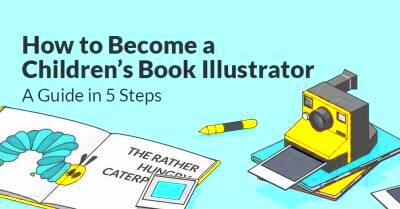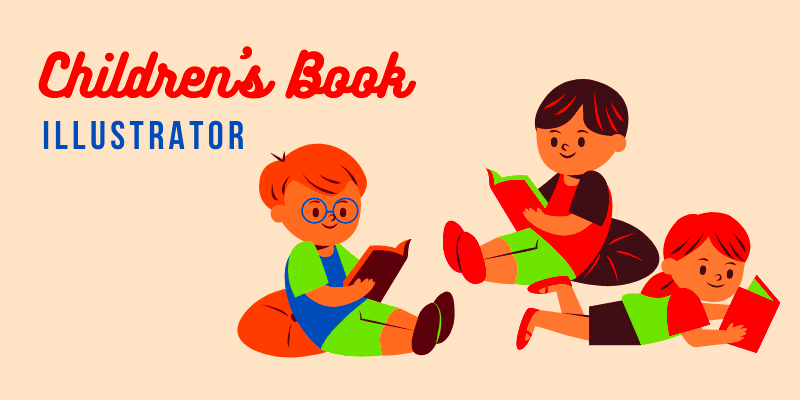As a children's book illustrator, you play a crucial role in bringing stories to life through your art. Your illustrations help to capture the imagination of young readers and complement the text in a way that enhances their understanding of the story. This means that your art must be engaging, colorful, and appropriate for the age group you are targeting.
Your illustrations not only tell a story but also evoke emotions, set the tone, and provide visual cues that guide children through the narrative. Understanding this responsibility is key to creating impactful artwork. Here are some important aspects of your role:
- Collaboration: You will often work closely with authors, editors, and publishers to ensure your illustrations align with the story's message.
- Creativity: It is essential to express your creativity in unique ways, adapting your style to suit different stories.
- Technical Skills: Familiarity with various illustration techniques and tools is necessary to produce high-quality artwork.
Building Your Artistic Skills and Style

Developing your artistic skills is a fundamental step toward becoming a successful children's book illustrator. Here are some tips to help you refine your craft:
- Practice Regularly: Set aside time each day to draw and experiment with new techniques. The more you practice, the better you will become.
- Study Other Illustrators: Analyze the work of established children's book illustrators. Look for inspiration in their styles, techniques, and how they convey emotions through art.
- Take Classes or Workshops: Consider enrolling in art classes or workshops focused on illustration. Learning from professionals can provide valuable insights and improve your skills.
- Find Your Unique Style: Experiment with different mediums and techniques until you discover a style that feels authentic to you.
Also Read This: What is a Revision in Fiverr?
Creating a Strong Portfolio for Children's Illustrations

Your portfolio is your calling card as an illustrator. It showcases your skills, style, and versatility to potential clients. Here’s how to create a strong portfolio:
- Select Your Best Work: Choose pieces that highlight your strengths and show a range of styles and subjects.
- Include Personal Projects: If you lack client work, include personal illustrations that demonstrate your creativity and skills.
- Present Your Work Professionally: Use high-quality images and a clean layout. Ensure each piece is well-lit and properly scanned or photographed.
- Tailor to Your Audience: If you want to work with a specific publisher or author, consider including illustrations that align with their style and themes.
Consider organizing your portfolio into sections, such as:
| Section | Description |
|---|---|
| Character Designs | Showcase various characters you've illustrated, highlighting your ability to create relatable figures. |
| Scene Illustrations | Include full-page illustrations that capture key moments in stories, demonstrating your storytelling ability. |
| Cover Art | Display any cover designs you've created, as this is a vital aspect of children's books. |
A well-organized and visually appealing portfolio will make a strong impression on potential clients and help you land projects in the competitive world of children's book illustration.
Also Read This: How to Get Fiverr’s Choice: A Comprehensive Guide
Finding Your Target Audience and Market
Identifying your target audience is essential for your success as a children's book illustrator. Understanding who your illustrations resonate with will help you create art that captivates young readers and appeals to publishers. Different age groups have varying preferences, so knowing your audience can guide your artistic choices.
Here are some tips for finding your target audience:
- Research Age Groups: Understand the different categories of children's books, such as picture books for toddlers, early readers, and middle-grade novels. Each group has distinct themes and styles.
- Analyze Market Trends: Keep an eye on what types of illustrations are currently popular in the market. Visit bookstores and browse online platforms to see what’s trending.
- Engage with Your Audience: Attend children's book fairs and workshops. Talk to parents, educators, and kids to gain insights into their preferences.
- Connect with Other Illustrators: Join online communities and forums where illustrators share their experiences and insights about their target markets.
By taking the time to identify your audience, you can tailor your portfolio and marketing efforts effectively, making it easier to connect with clients who are looking for your specific style and approach.
Also Read This: Does Fiverr Do Taxes? Understanding Your Responsibilities as a Seller
Setting Up Your Freelance Business as an Illustrator
Starting your freelance business as a children’s book illustrator involves several steps that will set you up for success. You want to ensure you have a solid foundation before diving into client work. Here’s what you need to consider:
- Establish Your Brand: Think about how you want to present yourself as an illustrator. Create a unique logo and consistent style across your portfolio and marketing materials.
- Set Up Your Online Presence: Build a professional website to showcase your portfolio. Use social media platforms to engage with your audience and share your work.
- Determine Your Rates: Research industry standards for illustration rates and set competitive pricing. Consider factors such as your experience, the complexity of the project, and the client's budget.
- Handle Legalities: Understand the contracts and agreements you will need when working with clients. Consider consulting with a legal professional to ensure your rights are protected.
Taking these steps will help you establish a credible and professional freelance business that attracts clients and showcases your talent effectively.
Also Read This: What Freelance Journalists Typically Make
Marketing Yourself to Publishers and Authors
Once you have set up your freelance business, it's time to focus on marketing yourself to publishers and authors. Building relationships in the industry is vital for securing illustration projects. Here are some strategies to help you get noticed:
- Create a Professional Portfolio: Ensure your portfolio highlights your best work and demonstrates your ability to meet the needs of various projects.
- Attend Industry Events: Participate in book fairs, writing conferences, and networking events. These gatherings provide opportunities to meet authors and publishers in person.
- Utilize Social Media: Share your illustrations on platforms like Instagram and Twitter. Use relevant hashtags and engage with the writing and publishing community.
- Direct Outreach: Research publishers and authors who create children's books. Reach out to them with a personalized email that introduces yourself and your work.
Consider creating a marketing table for your outreach strategy:
| Strategy | Description |
|---|---|
| Cold Emails | Send tailored emails to publishers and authors showcasing your work and expressing your interest in collaboration. |
| Social Media Campaigns | Create campaigns highlighting your illustrations, targeting relevant audiences and industry professionals. |
| Networking | Attend events and build relationships with other professionals in the publishing industry. |
By actively marketing yourself, you increase your chances of landing projects and building a successful career as a freelance children's book illustrator.
Also Read This: How to Use Promo Codes for Fiverr Users
Managing Your Freelance Work and Client Relationships
As a freelance children's book illustrator, managing your work and maintaining positive client relationships are crucial for your success. Balancing creativity with the demands of business can be challenging, but with the right strategies, you can create a productive workflow and build lasting connections with your clients.
Here are some tips to help you manage your freelance work effectively:
- Organize Your Schedule: Use calendars and task management tools to keep track of deadlines and project milestones. This will help you stay on top of your workload.
- Communicate Clearly: Establish open lines of communication with your clients. Be clear about your process, timelines, and any potential challenges that may arise.
- Set Realistic Deadlines: When agreeing on timelines, consider your other commitments to ensure you can deliver high-quality work on time.
- Seek Feedback: Don't hesitate to ask for feedback throughout the project. This not only helps you improve but also shows clients that you value their input.
Managing client relationships is equally important. Here are some strategies:
- Be Professional: Always respond promptly to inquiries and be courteous in all communications.
- Build Trust: Deliver on your promises and meet deadlines. Consistency builds trust and encourages repeat business.
- Express Gratitude: Thank your clients for their business and consider sending follow-up notes after completing a project.
By managing your work effectively and nurturing client relationships, you will pave the way for a successful freelance career.
Also Read This: What is a Buyer and Seller on Fiverr?
Frequently Asked Questions About Freelance Illustration
As you embark on your journey as a freelance children’s book illustrator, you might have some questions. Here are answers to some common queries:
| Question | Answer |
|---|---|
| How do I find clients? | Networking, attending industry events, and using social media platforms are great ways to find potential clients. |
| What should I charge for my illustrations? | Research industry standards and consider factors like your experience and the complexity of the project to determine your rates. |
| How long does it take to complete an illustration? | Completion time can vary based on the project's complexity, but it’s important to set realistic deadlines based on your schedule. |
| Do I need a contract for every project? | Having a contract helps protect both you and the client. It's a good practice to use contracts for all projects. |
If you have other questions, don't hesitate to seek advice from experienced illustrators or consult online resources for additional information.
Conclusion and Final Thoughts on Your Journey
Becoming a successful freelance children's book illustrator is an exciting journey filled with opportunities for creativity and personal growth. As you navigate this path, remember that it takes time, dedication, and perseverance to establish yourself in the industry. Embrace every step of the process, and don't be afraid to learn from your experiences.
As you move forward, keep these key takeaways in mind:
- Practice Your Craft: Continuously work on improving your skills and developing your unique artistic style.
- Network Effectively: Build relationships with authors, publishers, and other illustrators to open doors for new opportunities.
- Stay Organized: Manage your time and projects efficiently to deliver high-quality work consistently.
- Be Open to Feedback: Use feedback from clients to grow and refine your skills.
With passion and hard work, you can carve out a rewarding career as a freelance children's book illustrator. Enjoy the journey and the stories you will help to tell!




